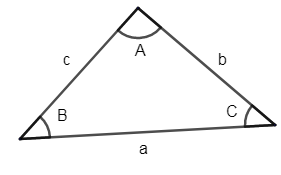
In a \[\Delta ABC,\left( a+b+c \right)\left( b+c-a \right)=\lambda bc\], then
a.\[\lambda <-6\]
b.\[\lambda >6\]
c.\[0<\lambda <4\]
d.\[\lambda >4\]
Answer
602.1k+ views
Hint: Apply basic trigonometric property and simplify the given expression. Then use the law of cosines in a triangle and get an equation with cosine function. Substitute and this takes the range of cosine function as \[-1<\cos A<1\].
Complete step-by-step answer:
Given to us a triangle ABC, let us consider the three sides of the triangle as a, b, c.
It is given that, \[\left( a+b+c \right)\left( b+c-a \right)=\lambda bc\].
We can arrange the terms and write as,
\[\left( \left( b+c \right)+a \right)\left( \left( b+c \right)-a \right)=\lambda bc-(1)\]
Now this is of the form, \[\left( x+y \right)\left( x-y \right)={{x}^{2}}-{{y}^{2}}\].
\[\therefore {{\left( b+c \right)}^{2}}-{{a}^{2}}=\lambda bc\]
Now, \[{{\left( x+y \right)}^{2}}={{x}^{2}}+{{y}^{2}}+2xy\]. Let us expand, \[{{\left( b+c \right)}^{2}}\].
\[\begin{align}
& \therefore {{b}^{2}}+{{c}^{2}}+2bc-{{a}^{2}}=\lambda bc \\
& {{b}^{2}}+{{c}^{2}}-{{a}^{2}}=\lambda bc \\
& {{b}^{2}}+{{c}^{2}}-{{a}^{2}}=\left( \lambda -2 \right)bc-(2) \\
\end{align}\]
From the triangle, a, b and c are sides.

A is the angle opposite to side a.
By law of cosines, we can say that,
\[\begin{align}
& {{a}^{2}}={{b}^{2}}+{{c}^{2}}-2bc\cos A \\
& \therefore {{b}^{2}}+{{c}^{2}}-{{a}^{2}}=2bc\cos A-(3) \\
\end{align}\]
Now substitute equation (3) in equation (2).
\[\begin{align}
& \therefore {{b}^{2}}+{{c}^{2}}-{{a}^{2}}=\left( \lambda -2 \right)bc \\
& 2bc\cos A=\left( \lambda -2 \right)bc \\
\end{align}\]
Cancel bc from LHS and RHS.
\[\therefore \cos A=\dfrac{\lambda -2}{2}\]
Now for \[\cos A\], \[-1<\cos A<1\].
\[\therefore \] Put, \[\cos A=\dfrac{\lambda -2}{2}\]
\[\begin{align}
& \Rightarrow -1<\dfrac{\lambda -2}{2}<1 \\
& =2<\lambda -2<2 \\
& =-2+2<\lambda <2+2 \\
& \therefore 0<\lambda <4 \\
\end{align}\]
Thus we got the range of \[\lambda \] as \[0<\lambda <4\].
\[\therefore \] Option (c) is the correct answer.
Note: The Law of cosine is useful for finding the \[{{3}^{rd}}\] side of a triangle when we know 2 sides and angle between them. And it is used for finding the angles of a triangle when we know all three sides.
Complete step-by-step answer:
Given to us a triangle ABC, let us consider the three sides of the triangle as a, b, c.
It is given that, \[\left( a+b+c \right)\left( b+c-a \right)=\lambda bc\].
We can arrange the terms and write as,
\[\left( \left( b+c \right)+a \right)\left( \left( b+c \right)-a \right)=\lambda bc-(1)\]
Now this is of the form, \[\left( x+y \right)\left( x-y \right)={{x}^{2}}-{{y}^{2}}\].
\[\therefore {{\left( b+c \right)}^{2}}-{{a}^{2}}=\lambda bc\]
Now, \[{{\left( x+y \right)}^{2}}={{x}^{2}}+{{y}^{2}}+2xy\]. Let us expand, \[{{\left( b+c \right)}^{2}}\].
\[\begin{align}
& \therefore {{b}^{2}}+{{c}^{2}}+2bc-{{a}^{2}}=\lambda bc \\
& {{b}^{2}}+{{c}^{2}}-{{a}^{2}}=\lambda bc \\
& {{b}^{2}}+{{c}^{2}}-{{a}^{2}}=\left( \lambda -2 \right)bc-(2) \\
\end{align}\]
From the triangle, a, b and c are sides.

A is the angle opposite to side a.
By law of cosines, we can say that,
\[\begin{align}
& {{a}^{2}}={{b}^{2}}+{{c}^{2}}-2bc\cos A \\
& \therefore {{b}^{2}}+{{c}^{2}}-{{a}^{2}}=2bc\cos A-(3) \\
\end{align}\]
Now substitute equation (3) in equation (2).
\[\begin{align}
& \therefore {{b}^{2}}+{{c}^{2}}-{{a}^{2}}=\left( \lambda -2 \right)bc \\
& 2bc\cos A=\left( \lambda -2 \right)bc \\
\end{align}\]
Cancel bc from LHS and RHS.
\[\therefore \cos A=\dfrac{\lambda -2}{2}\]
Now for \[\cos A\], \[-1<\cos A<1\].
\[\therefore \] Put, \[\cos A=\dfrac{\lambda -2}{2}\]
\[\begin{align}
& \Rightarrow -1<\dfrac{\lambda -2}{2}<1 \\
& =2<\lambda -2<2 \\
& =-2+2<\lambda <2+2 \\
& \therefore 0<\lambda <4 \\
\end{align}\]
Thus we got the range of \[\lambda \] as \[0<\lambda <4\].
\[\therefore \] Option (c) is the correct answer.
Note: The Law of cosine is useful for finding the \[{{3}^{rd}}\] side of a triangle when we know 2 sides and angle between them. And it is used for finding the angles of a triangle when we know all three sides.
Recently Updated Pages
Master Class 11 Economics: Engaging Questions & Answers for Success

Master Class 11 English: Engaging Questions & Answers for Success

Master Class 11 Social Science: Engaging Questions & Answers for Success

Master Class 11 Biology: Engaging Questions & Answers for Success

Class 11 Question and Answer - Your Ultimate Solutions Guide

Master Class 11 Business Studies: Engaging Questions & Answers for Success

Trending doubts
10 examples of friction in our daily life

One Metric ton is equal to kg A 10000 B 1000 C 100 class 11 physics CBSE

Difference Between Prokaryotic Cells and Eukaryotic Cells

1 Quintal is equal to a 110 kg b 10 kg c 100kg d 1000 class 11 physics CBSE

Explain zero factorial class 11 maths CBSE

What is a periderm How does periderm formation take class 11 biology CBSE




